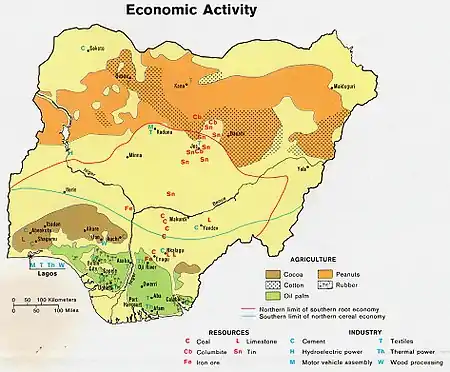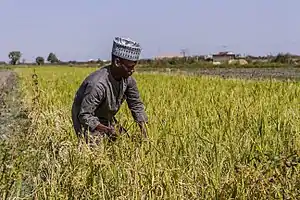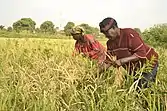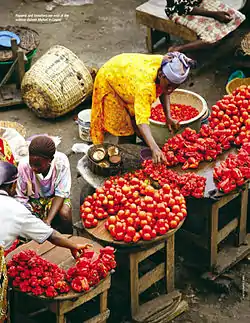Agriculture in Nigeria
Agriculture in Nigeria is a branch of the economy in Nigeria, providing employment for about 35% of the population as of 2020.[1] As reported by the FAO,[2] agriculture remains the foundation of the Nigerian economy, despite the presence of oil in the country. It is the main source of livelihood for most Nigerians. The Agricultural sector is made up of four sub-sectors: Crop Production, Livestock, Forestry and Fishing. In the third quarter of 2019, the sector grew by 14.88% year-on-year in nominal terms with a decline of 3.44% points from the third quarter of 2018. The largest driver of the sector remains Crop Production as it accounts for 91.6% of the sector in the third quarter of 2019 with a quarterly growth which stood at 44.12%. The Agriculture sector contributed 29.25% to overall real GDP during the third quarter of 2019.[3]
The sector is being transformed by commercialization at the small, medium and large-scale enterprise levels.[4] On the other hand, the Nigerian Agricultural sector has encountered several challenges ranging from an obsolete land tenure system that limits access to land (1.8 ha/farming household), a very low level of irrigation development (less than 1 percent of cropped land under irrigation), limited adoption of research findings and technologies, high cost of farm inputs, poor access to credit, inefficient fertilizer procurement and distribution, insufficient storage facilities and poor access to markets and more recently, changes in average temperatures, rainfall, climate extremes and infestation of pests and diseases causing organisms precipitated by climate change pose great challenge to agriculture.[5] This is coupled with a high dependence on rainfed agriculture which has made the Agricultural Production System highly vulnerable to adverse seasonal variations.[6] These have all contributed to low agricultural productivity (average of 1.2 metric tons of cereals/ha) with high postharvest losses and waste in Nigeria.[2]
Dynamics
Food export accounted for more than 70 percent of the GNP of Nigeria at independence. Twenty-five years later, it was almost a complete reversal with food items accounting for over 50 percent of imports. Food output however declined after independence, although, many parts of Sub-Saharan Africa were fertile and potentially productive, per capita food out declined, grain imports then increased more than seven times.[7] The usage of inorganic fertilizers was therefore promoted by the Nigerian government in the 1970s.[8] In 1990, 82 million hectares out of Nigeria's total land area of about 91 million hectares were found to be arable. 42 percent of the cultivable area was farmed. Much of this land was farmed under the bush fallow system, whereby land is left idle for a period of time to allow natural regeneration of soil fertility. 18 million hectares were classified as permanent pasture, but had the potential to support crops. Most of the 20 million hectares covered by forests and woodlands are believed to have agricultural potentials.[9]
Agricultural holdings are small and scattered, and farming is carried out with simple tools. Large-scale agriculture is not common. Agriculture contributed 32% to GDP in 2001.[10]
Production
Nigeria produced in 2018:
- 59.4 million tons of cassava (the largest producer in the world). Nigeria accounts for cassava production of up to 20 per cent of the world, about 34 per cent of Africa’s and about 46 per cent of West Africa’s.[2]
- 47.5 million tons of yam (largest producer in the world);
- 10.1 million tons of maize (14th largest producer in the world);
- 7.8 million tons of palm oil (4th largest producer in the world, second only to Indonesia, Malaysia and Thailand);
- 7.5 million tons of vegetable;
- 6.8 million tons of sorghum (2nd largest producer in the world, second only to the United States);
- 6.8 million tons of rice (one of the largest producers of rice in Africa,[2] 14th largest producer in the world);
- 4 million tons of sweet potato (3rd largest producer in the world, second only to China and Malawi);
- 3.9 million tons of tomato (11th largest producer in the world);
- 3.3 million tons of taro (largest producer in the world);
- 3 million tons of plantain (5th largest producer in the world);
- 2.8 million tons of peanut (3rd largest producer in the world, second only to China and India);
- 2.6 million tons of cowpea (largest producer in the world);
- 2.2 million tons of millet (4th largest producer in the world, second only to India, Niger and Sudan);
- 2 million tons of okra (2nd largest producer in the world, second only to India);
- 1.6 million tons of pineapple (7th largest producer in the world);
- 1.4 million tons of sugarcane;
- 1.3 million tonnes of potato;
- 949 thousand tons of mango (including mangosteen and guava);
- 938 thousand tons of onion;
- 833 thousand tons of papaya (6th largest producer in the world);
- 758 thousand tons of soy;
- 747 thousand tons of green pepper;
- 585 thousand tons of egusi;
- 572 thousand tons of sesame seed (4th largest producer in the world, losing only to Sudan, Myanmar and India);
- 369 thousand tons of ginger (3rd largest producer in the world, losing only to India and China);
- 332 thousand tons of cocoa (4th largest producer in the world, second only to Ivory Coast, Ghana and Indonesia);
- 263 thousand tons of sheanut;
In addition to smaller productions of other agricultural products.[11]
Nigeria produced about 2.2 million metric tons of fish per year in 2008.[2] Livestock production is an essential component of Nigeria agriculture with abundant social and economic potentials. About 60 percent of the ruminant livestock population is found in the country’s semi-arid zone and mostly managed by pastoralists. Domestic production of livestock products is far below the national demand, resulting in large imports of livestock and livestock products. Except for eggs, the domestic production of animal products is less than half the demand for beef mutton and goat meat, while for milk and pork products it is less than quarter the demand[2]
Agricultural products

Major crops include beans, rice, sesame, cashew nuts, cassava, cocoa beans, groundnuts, gum arabic, kolanut, maize (corn), melon, millet, palm kernels, palm oil, plantains, rice, rubber, sorghum, soybeans, bananas and yams.
In the past, Nigeria was famous for the export of groundnut and palm kernel oil. But over the years, the rate of exportation of this produce has reduced. A few years back local Nigerian companies have commenced exporting groundnuts, cashew nuts, sesame seeds, moringa seeds, Ginger, cocoa etc.
The country's agricultural products fall into two main groups: food crops produced for home consumption, and cash crops sold for profits and also exported abroad. Prior to the Nigerian civil war, the country was self-sufficient in food, but increased steeply after 1973. Bread made from American wheat replaced domestic crops as the cheapest staple food.[10] Between 1980 and 2016, yam production increased from more than 5 million tonnes to 44 million tonnes.[12]
| Tonnes produced in | 1980 | 2000 | 2016 |
|---|---|---|---|
| Maize | 612,000[13] | 4,107,000[13] | 764,678[14] |
| Millet | 2,824,000[15] | 5,814,000[15] | 1,468,668[14] |
| Guinea corn | 3,690,000[16] | 7,711,000[16] | 6,939,335[14] |
| Yam | 5,250,000[12] | 26,210,000[12] | 44,109,615[14] |
| Cassava | 11,500,000[17] | 32,697,000[17] | 57,134,478[14] |
| Rice, paddy | 1,090,000[18] | 3,298,000 | 6,070,813[14] |
| Melon seed | 94,000[19] | 345,000[19] | 569,398[14] |
| Cocoyam | 208,000[20] | 3,886,000[20] | 3,175,842[14] |
| Sesame seed | 15,000[21] | 72,000 | 460,988[20] |
Cocoa
Cocoa is the leading non-oil foreign exchange earner but the dominance of smallholders and lack of farm labour due to urbanization hold back production. In 1969, Nigeria produced 145,000 tons of cocoa beans, but has the potential for over 300,000 per year. For more productivity, Nigerian Government should give more incentives to cocoa farmers[10]
Rubber is the second-largest non-oil foreign exchange earner.
Oil palm
The palms industry constitutes a significant sector of the Nigerian economy, providing food and raw materials for the Food, Cosmetics, Pharmaceuticals, Plastics and the Bio-energy industries. In Nigeria the institute that has valuable information about oil palm is the Nigerian Institute for Oil Palm Research. The formal mandate of the institute is to conduct research into the production and products of oil palm and other palms of economic importance and transfer its research findings to farmers.[22]
Cash crop production
Cash crop production historical statistics in Nigeria:[14]
| Tonnes produced in | 1980 | 2000 | 2016 |
|---|---|---|---|
| Oil Palm fruit | 5,750,000 | 8,220,000 | 7,817,207 |
| Cocoa | 153,000 | 338,000 | 236,521 |
| Groundnut | 471,000 | 2,901,000 | 3,028,571 |
| Kola nut | 135,000 | 82,000 | 143,829 |
| Ginger | 200 | 98,000 | 522,964 |
Traditional native crops
Traditional native cereals such as fonio (Digitaria exilis and Digitaria iburua) are still grown in the Middle Belt of central Nigeria.[23]
Other traditional native crops in Nigeria are:[23]
Ministry of Agriculture

The government office responsible for Agriculture development and transformation is currently the Federal Ministry of Agriculture and Rural Development. Primarily funded by the Federal Government, the Ministry currently superintends almost fifty parastatals operating as either key departments or agencies across the country. The Ministry has 2 major departments namely Technical and Service Departments:
- Technical Departments: Agriculture (Trees and Crops), Fisheries, Livestock, Land Resources, Fertilizer, Food Reserve & Storage and Rural Development.
- Service Departments: Finance, Human Resources, Procurement, PPAS (Plan, Policy, Analysis & Statistics) and Co-operatives.
The ministry is headed by Audu Ogbeh who was appointed by President Muhammad Buhari on 12 November 2015 succeeding Akinwumi Adesina who was elected to head Africa Development Bank. Buhari also appointed Heineken Lokpobiri as the new Minister of State for Agriculture, and Shehu Ahmad as the Permanent Secretary under a newly created Ministry of Agriculture And Rural Development.[24]
Policies



In 2011, the administration of President Jonathan launched an Agricultural Transformation Agenda which was managed by the Federal Ministry of Agriculture and Rural Development. The intended outcome of the agenda is to promote agriculture as a business, integrate the agricultural value chain and make agriculture a key driver of Nigeria's economic growth.[25] To achieve this agenda the government put in place some new measures:
- New fiscal incentives to encourage domestic import substitution
- Removal of restrictions on areas of investment and maximum equity ownership in investment by foreign investors
- currency exchange controls – free transfer of Capital, Profits and Dividends
- Constitutional guarantees against nationalization/expropriation of investments
- Zero percent (0%) duty on agricultural machinery and equipment imports
- Pioneer Tax holiday for agricultural investments
- Duty Waivers and other industry related incentives e.g., based on use of local raw materials, export orientation
Recently, the Central Bank of Nigeria began the Anchors-Borrow program [26] to encourage the cultivation of certain crops, especially rice.
The FG of Nigeria has also closed it land borders in other to curtail rice imports and encourage local production.[27][28]
See also
References
- "Employment in agriculture (% of total employment) (modeled ILO estimate) - Nigeria". Work Bank Data. World Bank. 2020. Retrieved 24 November 2020.
- "Nigeria at a glance | FAO in Nigeria | Food and Agriculture Organization of the United Nations". www.fao.org. Retrieved 2020-11-24.
- Nigerian Gross Domestic Product Report Q3 2019, National Bureau of Statistics. https://www.nigerianstat.gov.ng/pdfuploads/GDP_Report_Q3_2019.pdf
- Olomola Ade S. (2007) “Strategies for Managing the Opportunities and Challenges of the Current Agricultural Commodity Booms in SSA” in Seminar Papers on Managing Commodity Booms in Sub-Saharan (: Africa: A Publication of the AERC Senior Policy Seminar IX. African Economic Research Consortium (AERC), Nairobi, Kenya
- Kurukulasuriya, Pradeep (2013). "Climate Change and Agriculture: A Review of Impacts and Adaptations". Climate Change Series 91 Environment Department Papers, World Bank, Washington, D.C.
- Olayide, Olawale Emmanuel; Tetteh, Isaac Kow; Popoola, Labode (December 2016). "Differential impacts of rainfall and irrigation on agricultural production in Nigeria: Any lessons for climate-smart agriculture?". Agricultural Water Management. 178: 30–36. doi:10.1016/j.agwat.2016.08.034. ISSN 0378-3774.
- Obasanjo, Olusegun (1988). Africa Embattled. Ibadan: Fountain Publications. p. 79. ISBN 9782679364.
- Pasquini, MW; Alexander, MJ (2005). "Soil fertility management strategies on the Jos Plateau: the need for integrating 'empirical' and 'scientific' knowledge in agricultural development". Geographical Journal. 171 (2): 112–124. doi:10.1111/j.1475-4959.2005.00154.x.
- Countries studies, Nigeria
- Nigeria agriculture
- Nigeria production in 2018, by FAO
- Verter, Nahanga (2015-05-01). "An Analysis of Yam Production in Nigeria". Acta Universitatis Agriculturae et Silviculturae Mendelianae Brunensis. 63: 659–665. doi:10.11118/actaun201563020659.
- "Nigeria Maize production, 1961-2017 - knoema.com". Knoema. Retrieved 2018-07-19.
- "FAOSTAT". www.fao.org. Retrieved 2018-07-19.
- "Quandl". www.quandl.com. Retrieved 2018-07-19.
- "factfish Sorghum, production quantity for Nigeria". www.factfish.com. Retrieved 2018-07-19.
- Philip; Taylor, D; Sanni, L; Okechukwu, R; Ezedinma, Chuma; Akoroda, M; Lemchi, J; Ilona, Paul; Ogbe, F (2005-03-01). "The Nigerian Cassava Industry Statistical Handbook". ISBN 978-978-131-268-7. Cite journal requires
|journal=(help) - "Nigeria Rice, paddy production, 1961-2017 - knoema.com". Knoema. Retrieved 2018-07-19.
- "factfish for Nigeria". www.factfish.com. Retrieved 2018-07-19.
- "factfish Taro, production quantity for Nigeria". www.factfish.com. Retrieved 2018-07-19.
- Adole, Sharon (2012). Economic Analysis of Sesame Production Among Small-Holder Farmers in Benue State, Nigeria (PDF) (Thesis). Ahmadu Bello University.
- "Oil Palm". www.nifor.gov.ng. Retrieved 12 May 2018.
- Blench, Roger (2006). Archaeology, language, and the African past. Altamira Press. ISBN 9780759104655.
- "Food Import Bill". Archived from the original on 2015-12-19. Retrieved 2015-11-11.
- Adesina, A. (2012, November 1). Agricultural Transformation Agenda: Repositioning agriculture to drive Nigeria’s economy. Retrieved from http://www.emrc.be/documents/document/20121205120841-agri2012-special_session-tony_bello-min_agric_nigeria.pdf Archived 2016-03-04 at the Wayback Machine
- editor (2020-03-01). "CBN and the Anchor Borrowers' ProgrammeE". ThisDayLive. Retrieved 2020-05-29.CS1 maint: extra text: authors list (link)
- "Nigeria's border crisis fuelled by rice". BBC News. 2019-10-31. Retrieved 2020-11-26.
- "You are being redirected..." businessday.ng. Retrieved 2020-11-26.
External links
- Agriculture & Animals Motherland Nigeria
- AgroNigeria: Nigeria's Agricultural Mouthpiece
- West African Agricultural Market Observer/Observatoire du Marché Agricole (RESIMAO)
- Major Farming Problems in Nigeria-Crop Farmers and Livestock Rearers
